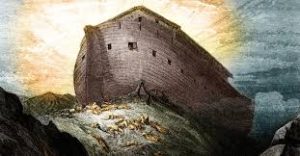The Written Account of the Generations of Noah
6:9 to 9:29

Moses edited and compiled twelve family documents in the book of Genesis. The major structural word for Genesis is toldot, which means the written account of, or this is what became of these men and their descendants. The noun is often translated generations, histories or descendants. After the section on the written account of the generations of Adam from 5:1 to 6:8, we have the fourth toldot, the written account of the generations of Noah. The previous toldot went from the blessing of Seth to the cursing of the demonic angels; however, this toldot goes from the cursing of the flood to the blessing of salvation. Therefore, what this fourth family document tells us is what became of Noah. And what became of Noah was that He was saved through the ark, which is a type of salvation through Christ (First Peter 3:20-21).
The entire Flood account follows an antithetical structure. There is a parallelism, where the first letter is antithetical to the second letter, and so on, with the letter F being the turning point.
A God resolves to destroy humanity with a Flood (6:11-13)
B Noah builds an ark (6:14-22)
C God commands Noah to enter the ark (7:1-9)
D The Flood begins (7:10-16)
E The Flood covers the earth for 150 days with the mountains covered (7:17-24)
F God remembers Noah (8:1a)
E The Flood recedes after 150 days and the mountains become visible (8:1b-5)
D The earth dries (8:6-14)
C God commands Noah to leave the ark (8:15-19)
B Noah builds an altar (8:20)
A God resolves never again to destroy humanity with a Flood (8:21-22)
The number seven is also very prominent in this toldot. Seven days are mentioned (7:4 and 10, 8:10 and 12). There are seven pairs of clean animals and birds (7:2-3). God spoke to Noah seven times (6:13; 7:1; 8:15; 9:1, 8, 12, 17). The Hebrew stem aseh, to do or to make, is used seven times in 6:13-22 in conjunction with the building of the ark. The root word to come is used seven times from 7:1-16. The stem of to destroy, erase or wipe out is used seven times in the Flood account. The word covenant is used seven times from 9:8-17. And finally, Noah’s name appears thirty-five (5X7) times in the entire Flood account.
Up to this point, we have seen the name of God alternate back and forth between Elohim and ADONAI. From 1:1 to 2:3 the name God or Elohim is used, because He is the God of Creation.
Then from 2:4 to 4:26 the name the LORD or ADONAI is used to emphasize that He is the One who always exists, the God of redemption and mercy. There are only a couple of exceptions to this. One is the temptation in 3:1-4, where Satan lies to Eve that she will become like God, the God of creation. And the other is in 4:25 where Eve says that God, the God of creation, has given her another child. Other than these few exceptions, the name the LORD or ADONAI is used throughout.
In Chapter 5 the name changes back to God, or Elohim, with the exception of 5:29. The reason for this change is that the righteous line of Seth is traced down to Noah and what is emphasized is that Elohim is the God of righteousness.
In 6:1-8 the name changes back to ADONAI, or the LORD because as man becomes more corrupt, the fact that He is the God of redemption and mercy is emphasized.
In this section these names will continue to change back and forth. The question is, why? The answer lies with Him and not man. When the Ruach Ha’Kodesh wants to emphasize God, the creator or destroyer, the God of righteousness, He uses Elohim. And when He wants to emphasize redemption and mercy, the One who always exists, He uses ADONAI, or the LORD.



Leave A Comment